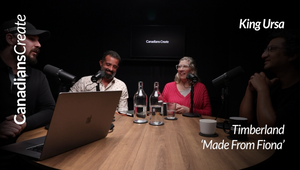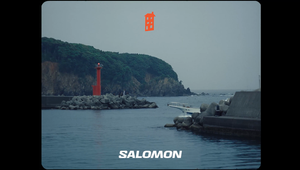
Dementia Meets Forced Rhubarb Farming in the Eerie World of ‘TUSKY’

Did you know that there is a small area in West Yorkshire that is world-famous for producing rhubarb, ominously dubbed the ‘Rhubarb Triangle’?
Well, Steven Boyle’s newest short, ‘TUSKY’ (a commonly-used Yorkshire word for rhubarb) will tell you all about it. Turns out, rhubarb farmers in West Yorkshire ‘force’ their rhubarb – a method of growing the plant in the dark, by candlelight, inside large ‘forcing’ sheds. A romantic, and terrifying image at once.
As a result of this process, forced rhubarb stalks become much more tender and sweeter than outdoor-grown rhubarb, as they don’t have to contend with the harsher growing conditions outside. Imagine it like the Kobe beef of rhubarb.
Back in 2012, this concept fascinated Steven Boyle to the point of him pitching a documentary concept about the Rhubarb Triangle, and while the pitch wasn’t immediately successful, the characters, atmosphere and aesthetic of the world he had built stayed with him.
“Visually it really spoke to me,” he says. “The vivid pink of the rhubarb stalks, the candle light, the eerie cracking of the rapidly growing plant – it was beautiful, atmospheric and a bit weird.” Not to mention the name ‘Rhubarb Triangle’ sounded extremely mysterious. So, Steven knew this was a story waiting to be told.
Fast forward to him coming across an article about dementia, Alzheimer’s and more specifically, Lewy body dementia, which detailed several real-life accounts of dementia-induced visual and auditory hallucinations. To his fascination and terror, Steven found himself immediately drawn to the darkness that came with this idea.
“Much of my existing visual research on forced rhubarb featured aging, male rhubarb farmers – and all of that imagery started to fit with the dementia angle. It seemed natural. The contrasting subjects of West Yorkshire rhubarb and dementia then became unlikely sparring partners in my head and, together, these subjects made up the raw materials for ‘TUSKY’.”
An early outline of the script came to fruition in 2016, was then actually created at the peak of the covid-19 pandemic in 2022, and finally saw the light of day on its ongoing festival run. To find out more about how this peculiar concept came to life, LBB’s Zoe Antonov spoke to director Steven Boyle.
LBB> Rhubarb farming plays a central role in your main character Harry’s life and identity. Can you share the significance of this unique setting and how it reflects the themes of the story?
Steven> In its simplest form, ‘TUSKY’ is the story of a retired rhubarb farmer ravaged by dementia – a man with the farming rituals of forced rhubarb deeply entrenched in his character. His world is very much an extension of his obsession, his purpose and daily routine a constant reminder of his duty to his crop. He’s a man longing for his old life. We all have our own routines, and the story explores the consequences of having these daily habits taken away from us.
LBB> In the film, Harry’s character experiences some disturbing hallucinations. How did you approach exploring the subjects of dementia, memory and perception?
Steven> During the writing stage, I did a huge amount of research into dementia and dementia-induced hallucinations, both visual and auditory. We also arranged a few Q&A sessions with some dementia specialists who had been on the ‘front line’ of dementia for most of their careers. Their stories and insights into the condition were an extremely valuable part of my process.
I shared my script with them and together, we systematically went through each scene where I posed a simple question: ‘could this actually happen?’. They didn’t reject any of it – everything in the script was feasible. What I took away from these sessions is that there is no one ‘typical case’ of dementia. It’s incredibly complex and completely unique to the individual.
‘TUSKY’ is obviously fictional, and at times, the story drifts into the surreal – but it was important to me that the script was still credible and rooted in fact. I wanted to portray Harry’s condition realistically and respectfully, so it was about finding the balance between the ‘realism’ and the more heightened elements of the script.
LBB> You’ve worked with two extraordinary actors, Phil Davis and Felicity Montagu. What drew you to them for these roles, and how did their performances help shape the film?
Steven> I’ve always been a huge admirer of Phil, and when his name came up in conversations with our casting director, Rae Hendrie, we got very excited and jumped at the chance to get him on board. For the role of Harry, we needed an actor with range, and Phil definitely has that. Crucially, he was able to externalise the nuanced, cognitive shifts of dementia and flit between fear, rage, confusion and vulnerability. The role also required a big physical performance, with Harry’s character also needing to pose a physical threat. It was a demanding role with many different layers, but Phil blew us all away with what he did. It was a real privilege watching him become Harry.

She’s probably best known for her role as Lynn in ‘Alan Partridge’ but she’s also excelled in many dramatic roles. When we saw her in HBO’s ‘Landscapers’ alongside Olivia Colman, we knew she’d be good for the role of Joyce, Harry’s struggling wife and carer. Felicity brought a lot to the role and was lovely to work with.

Again, none of this would have happened without the amazing Rae Hendrie. She was instrumental in getting my script out there and in front of the right people, and directly helped us secure Phil and Felicity.
LBB> The pandemic posed unique challenges for productions in 2022. How did it affect your creative process and the filming of ‘TUSKY’?
Steven> We shot ‘TUSKY’ (which had the working title of ‘Rhubarb Rhubarb’ then) back in March 2022, when the industry was still operating under strict covid-19 restrictions. Short film productions can be extremely fragile at the best of times, and the pandemic made it so much harder.
It was already shaping up to be a complex shoot. We had to plan our shooting schedule around an unpredictable, seasonal rhubarb crop, and there was a stunt scene and several VFX sequences to shoot. We also had a scene that featured live moths that needed to be wrangled, and like most short films, we had a very limited budget and a very tight shooting schedule.
Our first shoot day was inside a rhubarb forcing shed at Tomlinson’s Rhubarb Farm in Pudsey, West Yorkshire. The first day of filming went well, and we were due to shoot the remaining four days in Westerham, Kent the following week. Unfortunately, the day before the Westerham shoot, Phil Davis tested positive for covid-19, which was almost catastrophic for the production. We had to stand down all of the crew as the production entered a nerve-shredding 10-day hiatus. At that point, it looked like the film would implode because we were also working around Phil and Felicity’s availability, and we ran the risk of losing all of our HODs and crew because all of the dates had shifted.
In a great show of support for the project, the location owners and the crew single-handedly saved the shoot. The location allowed the art department to leave the sets dressed until Phil could provide a negative test and was well enough to continue filming. Almost all of our original crew returned 10 days later to finish the shoot.

LBB> Speaking of the crew, can you tell me more about your most crucial collaborators on this project and what they brought to it.
Steven> Every head of department and crew member gave so much to the film – we had a fantastic team, with many of them being good friends and industry colleagues that we’ve been working with for years. My producer, Nicola Dempsey, and RASCAL’s Andrew ‘Barnsley’ Wood, our VFX supervisor and executive producer, were my longest and closest collaborators on ‘TUSKY’.
For a short, ‘TUSKY’ was a bit of a beast. The script was ambitious with some complex scenes and heavy VFX sequences (76 VFX shots in total). All of that translated into a big workload for Barnes and myself. As a low budget short, the VFX work needed to slot in and around everyone’s other work commitments, so for the most part, we had to chip away at the film over many weekends. There was no point in rushing and compromising the quality of the work, so we just worked on it whenever we had a gap in our schedules.
The film went into post-production in late December 2022, and the last VFX shot was completed in April 2024, so it was cooking in the lab for a while. Barnes was our biggest ally – he’s an incredible artist with an amazing eye, and his VFX work helped elevate the film to new levels. It was a joyful collaboration.
Other key collaborators include our editor, Bruce Townend at The Quarry. Bruce did a great job and was hugely generous with his time. I also had a lovely collaboration with composer Benjamin Doherty, whose score added so much to the tone and emotional impact of the film, and Formosa worked wonders on the sound design and mix.
We also worked very closely with Steve West at Lazy Chief, a brilliant motion designer and artist who created all of the film’s branding and title design.
Robert Tomlinson of Tomlinson’s Farm and the rhubarb community of West Yorkshire were also great supporters.
LBB> ‘TUSKY’ was crowdfunded – a testament to the passion and belief in the project. What was it like working within the constraints of a low-budget production, and how did the support from your backers impact the project?
Steven> After a lot of work getting the script into a good place, we launched our Kickstarter campaign in the summer of 2021 and managed to raise the majority of our production budget. This film really wouldn’t exist without the enormous generosity of our backers – we were blown away by their support. People responded to the film’s early concept art and visuals, they believed in the idea and wanted to see the film get made. That was an incredible boost for myself and Nicola.
Our final production budget was around the £20 thousand mark, which was small for such an ambitious script. Making anything on a low budget is always a challenge, but you just have to try and cut your cloth accordingly and use your time and resources intelligently. Prepare, keep it tight, and work fast.
Ultimately, we had a great crew and some amazing collaborators on board, and the whole production was powered by a lot of good will. We are a director and producer husband and wife team, and I think people saw us trying to get this weird little passion project off the ground and wanted to help. Looking back, it just feels like we made this film with our friends, and we made a few new ones along the way.
LBB> As a dark drama, the tone and visuals of ‘TUSKY’ play a crucial role in its storytelling. What was your vision for the film’s aesthetic and how did you work with your team to bring it to life?
Steven> ‘TUSKY’ is a small, contained story that touches on the issue of rural isolation and loneliness of old age. Harry and Joyce are cut off from the outside world, living a very insular and lonely existence – it’s a dark place and the film’s overall aesthetic needed to embody those themes.
When I was writing the script, two animated films were floating around my head, Martin Rosen’s ‘Watership Down’, and Raymond Briggs’ ‘When the Wind Blows’. Both films are set in rural Britain and have an unnerving darkness about them. Tonally, they were both big influences, and they even informed some elements of ‘TUSKY’s look and aesthetic. But don’t expect any rabbits.
The dark tone also extends to the film’s cinematography and camera language. I worked closely with cinematographer Gary Shaw (‘Moon’, ‘His Dark Materials’) who helped create an oppressive domestic environment that felt a little unsettling and slightly claustrophobic. The story takes place during the winter months (rhubarb season), so the light levels lean into the dark and drab, compounding Harry’s torment and domestic captivity. Where possible, we tried to use wide shots sparingly, to add to the feeling of confinement and being trapped. I love working with Gary, he’s a brilliant DOP, super smart, very resourceful, and full of solutions. We spent a lot of time on this film lurking in the shadows together.
Long before the cameras started rolling, I had discussions with our production designer, Tom Gander, and costume designer, Justine Luxton, to make some key decisions on ‘TUSKY’s very controlled colour palette. With the costume and house interiors, I wanted to try and avoid strong colours, opting instead for a more muted and earthy colour palette. The only colour that needed to be dominant was the vivid pink of Harry’s rhubarb, which is a key visual motif throughout the film.
In the grade, I worked with Rascal colourist Dan Levy who helped get ‘TUSKY’s look where it needed to be.
LBB> The film has already made waves at festivals like Aesthetica, Norwich, and Foyle, even receiving a special mention in Foyle’s Best British Short Film category. How does it feel to see ‘TUSKY’ resonate with festival juries and audiences, and what do you hope they take away from the film?
Steven> It was great to have our UK premiere at the Aesthetica Film Festival in York, the land of rhubarb. The programming at Norwich and Foyle was also excellent. So far, the film has been well received, so we’re happy for everyone involved with the project. ‘TUSKY’ is a uniquely British film, and those not familiar with the world of Yorkshire-forced rhubarb may be scratching their heads a little, but I’m also fine with that – not everything needs to be explained. This film isn’t for everyone, but my hope is that audiences connect with the story on some level – it may resonate with those who have experienced dementia in their families, it could hit hard for some. Or, maybe they’ll just leave the screening thinking about rhubarb crumble.
LBB> With ‘TUSKY’ set to continue its festival journey in 2025, what are your hopes for the film’s future? Are there particular milestones or audiences you’d love it to reach?
Steven> We’ve started pretty well in the UK, and ‘TUSKY’ just had its European premiere in Berlin at British Shorts. It would be nice to get into some American festivals, but we’ll just have to wait to see how well rhubarb travels.















